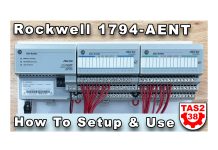
In today’s article we’ll compare the new 5380 CompactLogix with the previously released 5370 “L3” line of A-B controllers.
Let’s start off with a comparison of the front of the processors themselves:
5370:
5380:
- LED Status Indicators
- Run switch
- SD card slot
- USB Port
- Four Digit Digital Status Display
- Processor and Field power connections
Above you can see the biggest difference (aside from the power connectors) is the new processors come with a four digit digital status display like Rockwell’s other new PAC products.
This is a very welcome addition as having the program and network status scrolling across the display is extremely helpful in the field.
Next, let’s look at the Ethernet capabilities of both models:
5370:
- Embedded two port 10/100MB Ethernet switch supporting DLR and a single IP address
- Up to 48 Ethernet/IP nodes
- Up to 16 axes of motion, average of 2 per ms
- By default, communication defaults to 20% of Processor Utilization
- Buffers sizes include 40 Unconnected, 32 Cached Message, and 16 Simultaneous Message
- Messages Per Second is listed as 400
5380:
- E
 mbedded dual configurable 10/100/1000MB Ethernet ports supporting DLR or two unique IP address* (feature planned for version 29, estimated availability July 2016)
mbedded dual configurable 10/100/1000MB Ethernet ports supporting DLR or two unique IP address* (feature planned for version 29, estimated availability July 2016) - Supports up to 55 Ethernet/IP nodes
- Supports up to 20 axes of motion, average of 32 per ms
- Communications do not impact the Processor Utilization (i.e. 0%)
- Buffers sizes include 256 Unconnected, 256 Cached Message, and 256 Simultaneous Message
- Messages Per Second is listed as 2000
Above you can see, the new 5380 has had some huge advantages over the 5370, with 1GB Ethernet ports that support increase node, axes, and buffers counts.
Next we’ll take a look at power and I/O:
5370:
 Requires purchase of 1769 Power Supply and End Cap
Requires purchase of 1769 Power Supply and End Cap- Supports up to 30 local 1769 I/O modules with additional power supplies and cables
- Power Supply and I/O come with terminal blocks
5380:
 Integrated Power Supple, End Cap included with processor.
Integrated Power Supple, End Cap included with processor.- Supports up to 31 local 5069 I/O modules
- Processor and I/O DO NOT come with terminal blocks, must order separately
- 5069 is higher speed and higher accuracy I/O, and now support being used as “near instant” event triggers
- Reduced module width, as well as reduced required clearance above and below modules
Besides the integrated power supply, the other take-away is the new 5069 I/O is higher speed and requires less space.
Now let’s look at memory:
5370:
 Comes in 1, 2, and 3MB versions
Comes in 1, 2, and 3MB versions- Requires 80% to be reserved for future firmware enhancements and runtime communication
5380:
- Comes in 2 and 4mb versions today, with .6, 1, and 3mb versions scheduled for July
- No memory reserve required, 100% may be used for applications
Bottom line: Even if you buy a model with the same memory size, you can actually use all of it which is like getting 20% extra.
Next, Let’s look at some important differences that didn’t quite fit into any of the other categories:
5370:
 Safety version available
Safety version available- Phase Manager supported
- Alarm Instructions supported (ALMA, ALMD)
- Supports version 20+
5380:
- 20% increased in capacity
- 5-20 times faster scan times and task switching (vs 5370)
- Task monitor now built into 5380 webpages
- Safety, Phase Manager, and ALM support to be added in future
- Supports version 28+
Finally, lets take a look at “Estimated Street Prices:”
[artadrr-smallpac-e]5370 with 2MB
-
L33ER ($2,854) + PA2 ($261) + ECR ($33) = $3,148
5380 with 2MB
-
L320ER ($3,132 ) + RTB64-SCREW ($50) = $3,182
Surprisingly, you get all the advantages of the 5380 controller for nearly the same price as the 5370.
And from what I can tell, the 5069 I/O seems priced similarity to the 1769 I/O, making it very tempting to migrate from an L33ER to an L320ER as long as you’re not using ALM instructions, Phase Manager, or the Compact GuardLogix version.
However, if you’re currently using any ERM model, your only 5380 choice today would be the expensive L340ERM, with an estimated street price of $7,544. In this case I wouldn’t expect those customers to migrate until the additional 5380 models are released, which I’m currently told is scheduled for this July.
If you’re thinking about migrating, or have a reason you can’t, I’d love to hear from you. Just submit the “post a comment or question” form below to leave you comments.
Until next time, Peace ✌️
If you enjoyed this content, please give it a Like, and consider Sharing a link to it as that is the best way for us to grow our audience, which in turn allows us to produce more content 🙂
Shawn M Tierney
Technology Enthusiast & Content Creator
Support our work and gain access to hundreds members only articles and videos by becoming a member at The Automation Blog or on YouTube. You’ll also find all of my affordable PLC, HMI, and SCADA courses at TheAutomationSchool.com.
- FactoryTalk Design Workbench First Look, CCW Comparison - December 19, 2025
- Drew Allen of Grace Technologies on Automation, Safety, and More (P256) - December 17, 2025
- Robotics in Warehouse Automation with Erik Nieves of Plus One Robotics (P255) - December 10, 2025

Discover more from The Automation Blog
Subscribe to get the latest posts sent to your email.





I have a question: I know for sure that you can comunicate with the 5370 with a PanelView800 panel (via ethernet or DH485)
Do you know if it is still possible to use that HMI with the new 5380?
Thanks for your question – I posted my reply in our new community here:
https://automation.locals.com/post/273510/can-the-panelview800-communicate-with-a-5380
Shawn Tierney,
Instructor at http://www.TheAutomationSchool.com